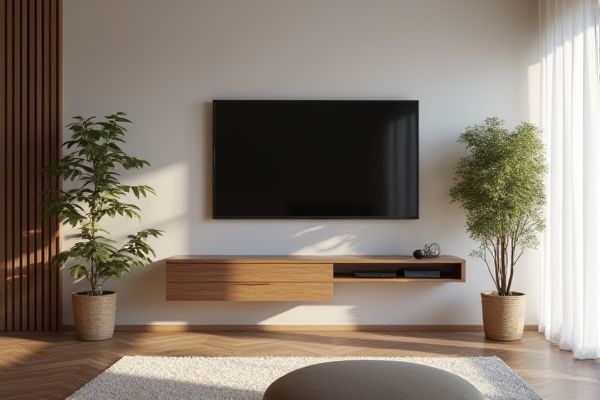
Wall-mounted TVs save valuable floor space and create a sleek, modern look, while TV stands offer extra storage and flexibility for positioning your screen. Discover which option best suits Your room's layout and lifestyle by reading the rest of the article.
Table of Comparison
| Feature | Wall-mounted TV | TV Stand |
|---|---|---|
| Space Efficiency | Saves floor space, ideal for small rooms | Occupies floor space, requires more room |
| Installation | Requires wall mounting, professional help recommended | Easy to set up, no installation needed |
| Viewing Angle | Adjustable with swivel mounts | Fixed, depends on furniture placement |
| Accessibility | Ports may be harder to reach | Easy access to ports and cables |
| Safety | Less risk of tipping over, but secure mounting essential | Risk of tipping especially in homes with children or pets |
| Aesthetics | Modern, sleek look | Offers storage options, decorative flexibility |
| Cost | Additional mounting hardware and installation costs | Typically included in furniture purchase, no extra fees |
Introduction to TV Display Options
Wall-mounted TVs offer a sleek, space-saving solution by attaching the screen directly to the wall, often enhancing room aesthetics and providing optimal viewing angles. TV stands provide flexibility with storage options for media devices, gaming consoles, and decor, making them a practical choice for multifunctional living spaces. Choosing between wall-mounted and TV stand setups depends on room layout, aesthetic preferences, and the need for additional storage or cable management.
Space Efficiency: Wall-Mounted TV vs TV Stand
Wall-mounted TVs maximize floor space, making your room appear larger and less cluttered, which is ideal for smaller living areas. TV stands often consume valuable floor space and require additional storage furniture, limiting flexibility in room layout. Choosing a wall-mounted TV enhances your space efficiency, giving you more room for other essential furniture or decor.
Aesthetics and Room Design
Wall-mounted TVs create a sleek, minimalist look by freeing up floor space and allowing for clean wall integration, ideal for modern and compact room designs. TV stands offer flexibility in placement and storage, complementing traditional or eclectic interiors with added functionality such as shelves for media devices and decor. Choosing between the two depends on balancing aesthetic preferences with practical needs, where wall mounts emphasize streamlined elegance and TV stands enhance room ambiance with tangible elements.
Installation Process and Considerations
Wall-mounted TV installation requires secure wall studs and specialized mounting brackets, ensuring stability and optimal viewing height, while TV stands offer simpler setup with minimal tools and flexibility to rearrange. Consider wall type, cable management, and room layout when choosing between mounting and stands, as wall mounts free floor space but limit mobility. Your choice depends on balancing aesthetic preferences, installation effort, and practical needs for access to ports and devices.
Cable Management Solutions
Wall-mounted TVs offer superior cable management solutions by concealing wires within the wall or specialized cable covers, creating a clean and clutter-free aesthetic. TV stands often require external cable organizers or clips to manage cords, which can result in visible wiring and less streamlined appearance. Optimal cable management enhances safety by reducing tripping hazards and protects cables from damage, making wall-mounted setups ideal for modern living spaces.
Safety and Stability Factors
Wall-mounted TVs offer enhanced safety by securely fastening the screen to the wall, reducing the risk of tipping over, especially in homes with children or pets. TV stands may provide stability but can be prone to accidental bumps or uneven surfaces, increasing the chances of falls. You should consider wall mounting for optimal safety and stability, minimizing hazards related to TV placement.
Accessibility and Viewing Angles
Wall-mounted TVs offer enhanced viewing angles by allowing flexible height and tilt adjustments, optimizing screen visibility from various seating positions. TV stands provide easier accessibility for connecting cables and devices, as ports remain within reach without needing to remove the television. Choosing between the two depends on balancing unobstructed viewing preferences with convenient access to TV inputs and controls.
Cost Comparison: Wall Mounts vs TV Stands
Wall-mounted TVs typically involve an initial cost for the mount, ranging from $20 to $200, and professional installation fees averaging $100 to $300, making them a higher upfront investment compared to TV stands priced between $50 and $400. Over time, wall mounts can save space and reduce the need for additional furniture, potentially offsetting costs in smaller living areas. TV stands offer more flexibility and storage options but may require more frequent replacements or upgrades, impacting long-term expenses.
Flexibility and Relocation
Wall-mounted TVs offer limited flexibility once installed, requiring more effort and potential wall repairs if you decide to relocate them. In contrast, TV stands provide easy mobility, allowing you to quickly rearrange or move your entertainment setup without tools. Your choice depends on how often you anticipate changing the room layout or moving homes.
Maintenance and Cleaning Tips
Wall-mounted TVs require regular dusting around the screen and ensuring the mounting brackets remain secure to prevent loosening over time. TV stands offer easier access for cleaning behind and beneath the unit, allowing for thorough dusting and cable management. Both setups benefit from using microfiber cloths and avoiding harsh chemicals to maintain screen clarity and hardware longevity.
 homyna.com
homyna.com